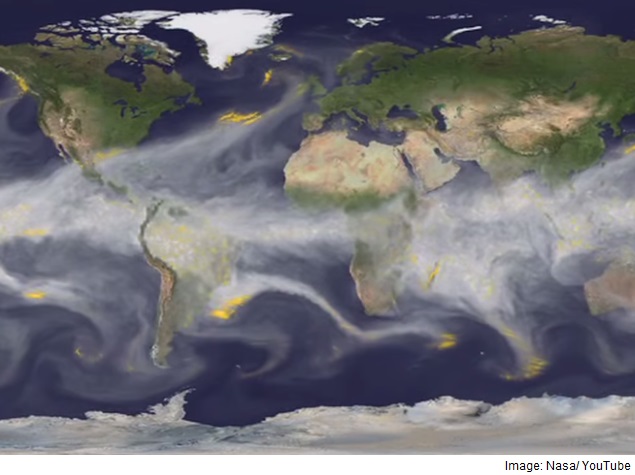- Home
- Science
- Science News
- Nasa Data Shows Rainwater Harvesting Could Help Indians
Nasa Data Shows Rainwater Harvesting Could Help Indians

The study is based on precipitation data from the Tropical Rainfall Measuring Mission (TRMM), a joint mission between Nasa and the Japan Aerospace Exploration Agency, which provided observations of rainfall over the tropics and subtropics from 1997 to 2015.
"India has severe problems getting potable water to all of its residents," said Dan Stout, research assistant in the Department of Civil Engineering at the University of Utah.
"We considered collecting water in a relatively small tank, and it's amazing the effect that doing something that small and simple can have on the Indian people," Stout said.
Rainwater harvesting is not a new concept, but researchers said it is a largely untapped resource in India.
In the new study, the team examined the possibilities if Indians collected precipitation in cheap 200-gallon tanks that they could easily engineer to fit in densely populated urban areas, such as many of India's growing cities.
The team analysed satellite data of precipitation in different areas to evaluate the availability of rainwater for direct harvesting. The team used data sets provided every three hours from 1997 to 2011 to determine how much precipitation, on average, was available for collection and supplementation in each of the six test cities: Bangalore, Delhi, Hyderabad, Kolkata, Mumbai, and Srinagar.
The team input TRMM data into algorithms that Stout developed to determine the benefit to each of two scenarios: indoor use and outdoor vegetable irrigation.
They estimated each person would require an average of about 35 gallons of water per day. For an average household of five people, demand would be about 178 gallons daily. Outdoor vegetable irrigation would require less water.
The team calculated irrigation demands for a roughly 215-square-foot garden planted with tomatoes and lettuce.
The team found rainwater harvesting provided for nearly 20 percent of the average indoor demand overall, though some seasons, such as southern monsoon season, provided more.
Rainwater harvesting provided sufficient water source for vegetable irrigation, which demands less water than indoor use.
While rainwater collection for irrigation resulted in fewer water bill savings, it did provide vitamin-rich food, profit from selling excess vegetables and a significantly shorter payback period for infrastructure, operation and maintenance required for the endeavour.
This can help boost cost savings and increase quality of life in India, researchers said in the study published in the Urban Water Journal.
After a one-year payback period, rainwater harvesting for vegetable irrigation would provide a profit of between Rs. 1,548 and Rs. 3,261 per year and a total cost savings of between Rs. 2,605 and Rs. 4,522 per year.
For the latest tech news and reviews, follow Gadgets 360 on X, Facebook, WhatsApp, Threads and Google News. For the latest videos on gadgets and tech, subscribe to our YouTube channel. If you want to know everything about top influencers, follow our in-house Who'sThat360 on Instagram and YouTube.
Related Stories
- Galaxy S24 Series
- MWC 2024
- Apple Vision Pro
- Oneplus 12
- iPhone 14
- Apple iPhone 15
- OnePlus Nord CE 3 Lite 5G
- iPhone 13
- Xiaomi 14 Pro
- Oppo Find N3
- Tecno Spark Go (2023)
- Realme V30
- Best Phones Under 25000
- Samsung Galaxy S24 Series
- Cryptocurrency
- iQoo 12
- Samsung Galaxy S24 Ultra
- Giottus
- Samsung Galaxy Z Flip 5
- Apple 'Scary Fast'
- Housefull 5
- GoPro Hero 12 Black Review
- Invincible Season 2
- JioGlass
- HD Ready TV
- Laptop Under 50000
- Smartwatch Under 10000
- Latest Mobile Phones
- Compare Phones
- Huawei Pura 70 Pro+
- Huawei Pura 70 Ultra
- Tecno Camon 30 Premier 5G
- Motorola Edge 50 Fusion
- Oppo A1i
- Oppo A1s
- Motorola Edge 50 Ultra
- Leica Leitz Phone 3
- Asus ZenBook Duo 2024 (UX8406)
- Dell Inspiron 14 Plus
- Realme Pad 2 Wi-Fi
- Redmi Pad Pro
- Cult Shock X
- Fire-Boltt Oracle
- Samsung Samsung Neo QLED 8K Smart TV QN800D
- Samsung Neo QLED 4K Smart TV (QN90D)
- Sony PlayStation 5 Slim Digital Edition
- Sony PlayStation 5 Slim
- IFB 2 Ton 3 Star Inverter Split AC (CI2432C323G1)
- Daikin 1 Ton 3 Star Inverter Split AC (FTKL35UV16W+RKL35UV16W)
















